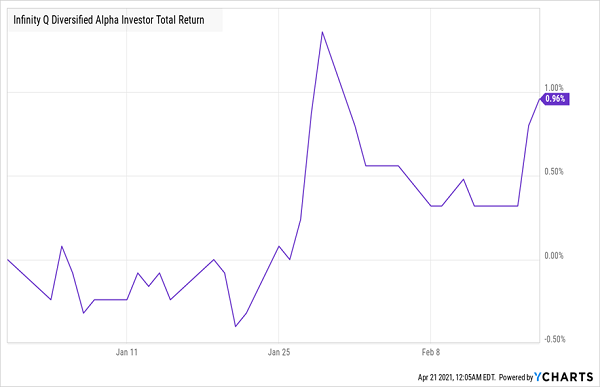In investing, it pays to follow the old adage from Warren Buffett: never put your money in anything you don’t understand—especially if no one can explain it.
We’ve seen the consequences of ignoring that advice play out with a mutual fund called the Infinity Q Diversified Alpha Fund (IQDAX). If you’re not familiar with the story, IQDAX investors were sideswiped when an independent analysis of the fund showed it had lost $500 million.
Losses are part of the game in investing, of course, and the fact that the fund was worth $1.7 billion means it won’t go to zero because of this situation. But what is worrying is that this fund’s management firm, Infinity Q Capital Management LLC, appears to not have known of its own losses beforehand.
So what’s going on here, and what can we dividend investors learn from it? The first thing is to look deeper than price charts when you’re evaluating a fund, because going by that alone, IQDAX looks like it’s turning in an okay, though not spectacular, performance.
Price Chart Masks Turmoil at IQDAX

But, of course, looks can be deceiving. Remember, the fund still hasn’t figured out how much it is actually worth.
At this point, you’re probably wondering how a fund can actually not know what it’s worth. It’s a valid question—really step 1 in evaluating any investment!
The answer, in this case, comes down to derivatives, enormously powerful financial tools Buffett himself once called “weapons of mass destruction.” The most visible example of the damage derivatives can do is the 2008/’09 housing-market crash.
In IQDAX’s case, derivatives became removed from the assets they are supposed to be connected to, causing losses in a portfolio that became enormously complicated. At the heart of the problem was a group of derivatives called variance swaps. Tailor-made by big banks, variance swaps help big investors make bets that a market like the S&P 500 will go above or below a specific price over a specific period of time.
This might sound like a bet on volatility, and it is—kind of. These swaps work in the same way that selling a mortgage-backed security was a bet on house prices back in ’08. In reality, variance swaps bet on the square of future volatility. Complicated math aside, it’s crucial to remember that volatility itself is a kind of derivative on stock prices, which means variance is a derivative of a derivative.
In short, Infinity Q was using a derivative that was an abstraction of an abstraction of reality, in much the same way the subprime-mortgage-crisis derivatives were bets on bets on bets on home prices. This kind of derivative has been mostly banned from Wall Street, but it’s still in some of the more esoteric pockets of finance.
And that’s the risk that unlucky holders of IQDAX have suddenly found themselves exposed to.
How to Keep This From Happening to You
It’s easy for individual investors like us to sidestep a trap like this. Just follow these three steps:
- As Buffett says, avoid any fund or financial product you do not understand and that cannot be explained to you in plain English.
- Avoid third-order derivatives—that is, assets whose price movements depend on the price movements of another derivative.
- Diversify into a variety of funds that focus on high-quality, tangible assets: stocks, bonds and real estate, for example.
On that third point, I recommend investing in a group of closed-end funds (CEFs) that can get you exposure to all three of those asset classes and a high dividend yield, too (the average CEF yields 7.2% today). That gives you most of your return in safe cash, and no, you won’t have any exposure to complex derivatives.
That is why almost all well-established CEFs have made a profit over the last decade, and over a hundred CEFs of the roughly 500 in existence have delivered over 10% annualized gains over the last 10 years or since their inception.
Anchor Your Portfolio With These 5 Steady 7.1% Dividends
When I say almost all well-established CEFs have made money, I’m not kidding around. Of all CEFs that are a decade old or older, 96% have made money over the last 10 years.
And when you drop oil and gas funds, that percentage rises to 99%!
That’s an incredible statistic, especially when you consider that CEFs offer huge dividends, too: as I said a second ago, the average CEF yields 7.2% today—and that’s just the average! Some of these funds kick out safe, steady payouts of 9% and more.
In fact, the 5 CEFs I’m urgently recommending now yield 7.1%, on average, today—enough to hand you a nice $38,000 yearly income stream on a $500K investment. PLUS, they’re bargains—so much so that I’m forecasting 20% price gains from this 5-fund “mini-portfolio” by this time next year.
That would add another $50,000 in gains to your $38,000 in dividends!
Full details on these 5 money-making CEFs are waiting for you now. Click here and I’ll give you all the info you need—names, tickers, complete dividend histories, buy-under prices and more.

Recent Comments